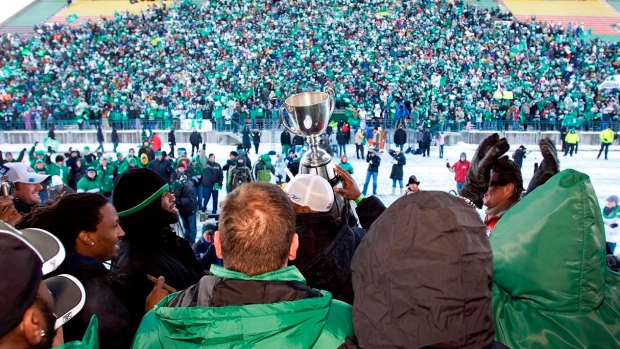Oct 28, 2016
Mosaic Stadium a reminder of a modest past
Roughriders fans turn the raw and efficient stadium into the beating heart of a province when their team takes the field, Dave Naylor writes.
By Dave Naylor

It’s not a place that will be remembered for its architecture, its amenities or even its sightlines.
No, Saskatchewan’s Mosaic Stadium is about as basic and simple as it comes in professional sports: a raw and efficient facility in a raw and efficient kind of place.
Built in chunks over the course of decades, it has the feel of a stadium that simply evolved for whatever was needed. It is the ultimate utilitarian facility, with not a penny spent on anything not absolutely necessary.
For most of the Saskatchewan Roughriders existence, that’s the way things had to be for the community-owned CFL franchise, one that has survived more by being prudent than because of its success on the field.
In fact, Mosaic is a place where the home team lost far more than it won, and where, for a long time, the Roughriders faced two challenges each season: winning football games and living to survive until the next season.
You could feel that sense of frugality every time you stepped into Mosaic, or at least you could before the economic fortunes of the province and the team began to turn during the past 20 years, making the stadium a reminder of a much more modest past.
These days the Roughriders are acknowledged as the CFL’s rich kids, with a rock-solid fan base, a merchandising arm that exceeds those of some teams in The Big Four and a new $278-million dollar facility ready for next season.
In that sense, the new stadium is a far better representation of how the province and the football team see themselves these days than the old one.
Mosaic itself didn’t offer much in the way of experiences, so it was the fans who delivered it, spontaneously, no matter how the team faired or how inclement the weather might be.
And so often the story at Mosaic has been the weather. Those brilliant, cloudless days of summer, often interrupted by a wind strong enough to turn punts into negative yards. Those brilliant Saskatchewan thunderstorms that light up the night sky. And of course the bitter cold of early winter, which could occasionally bring as much bite as a raw day in January.
It’s location in west-end neighbourhood made the team feel that much closer to the community, it’s tall southern grandstand one of the first things you notice when arriving to Regina by airplane.
If the lack of modern amenities bothered the fans, it sure didn’t seem to affect their attitude on game day, where the local passion for the Roughriders was expressed as being part of one great big, giant, green tribe.
Doing so in a place that has spanned generations is what brought the stadium's charm to life, while at the same time reminding fans of tradition, past glories and a simpler, if not necessarily better, time.
On those 10 days every year when the Roughriders played, it became the giant, beating heart of a province, the stands packed with fans dressed in nearly every piece of clothing imaginable in Rider green.
It won’t be quite the same at the new facility next season, which isn’t to suggest it will be worse, or that the Roughriders weren’t long overdue for a home that will make both them and their fans much more comfortable.
They are no longer the have-nots of the CFL and haven’t been for a while. They’re a big business, a national brand, and a team with some significant economic might.
It was time to move on, time to move into the present. It's time to say goodbye.



